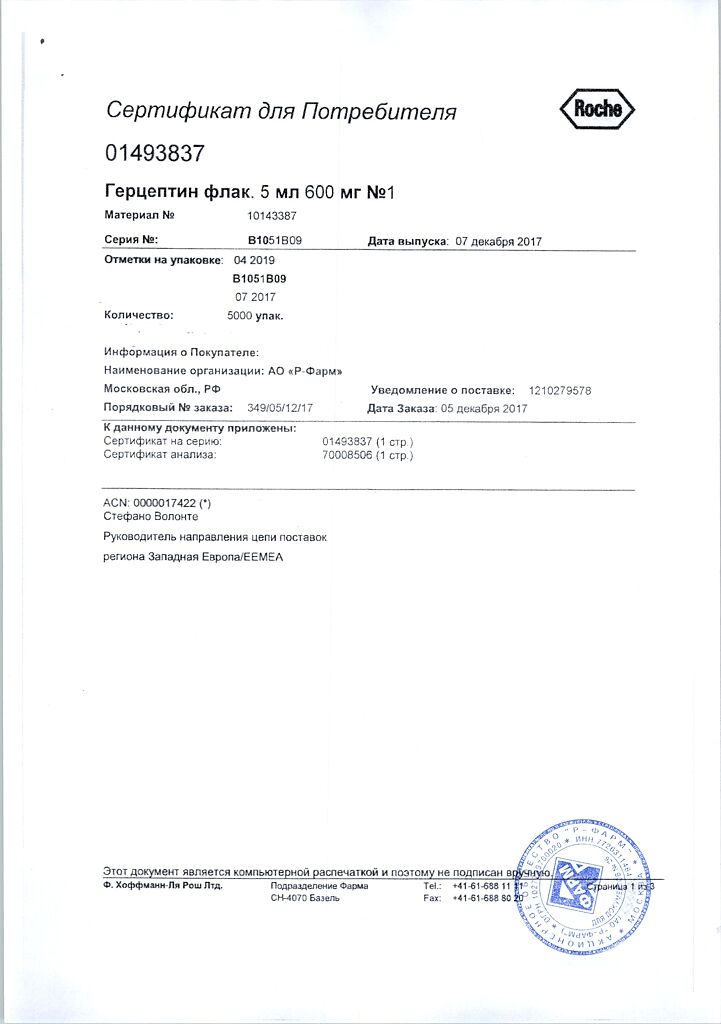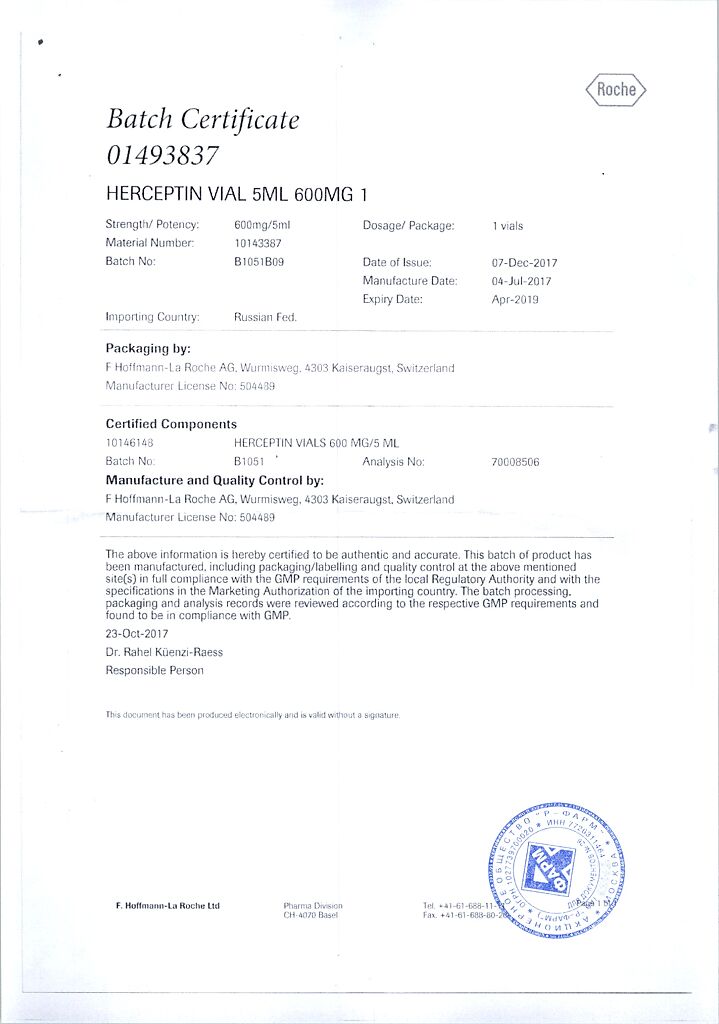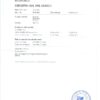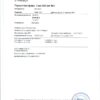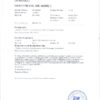No products in the cart.
Description
Metastatic breast cancer with tumor overexpression of HER2:
– as monotherapy, after one or more chemotherapy regimens;
– in combination with paclitaxel or docetaxel, in the absence of prior chemotherapy (first-line therapy);
– in combination with aromatase inhibitors for positive hormone receptors (estrogen and/or progesterone) in postmenopausal women.
Early stages of breast cancer with tumor overexpression of HER2:
– As adjuvant therapy after surgery, completion of chemotherapy (neoadjuvant or adjuvant) and radiation therapy;
– in combination with paclitaxel or docetaxel after adjuvant chemotherapy with doxorubicin and cyclophosphamide;
– In combination with adjuvant chemotherapy consisting of docetaxel and carboplatin;
– In combination with neoadjuvant chemotherapy followed by adjuvant monotherapy with Herceptin® if the disease is locally advanced (including inflammatory form) or if the tumor is larger than 2 cm in diameter.
Pharmacokinetics
Metastatic breast cancer with tumor overexpression of HER2:
– as monotherapy, after one or more chemotherapy regimens;
– in combination with paclitaxel or docetaxel, in the absence of prior chemotherapy (first-line therapy);
– in combination with aromatase inhibitors for positive hormone receptors (estrogen and/or progesterone) in postmenopausal women.
Early stages of breast cancer with tumor overexpression of HER2:
– As adjuvant therapy after surgery, completion of chemotherapy (neoadjuvant or adjuvant) and radiation therapy;
– in combination with paclitaxel or docetaxel after adjuvant chemotherapy with doxorubicin and cyclophosphamide;
– In combination with adjuvant chemotherapy consisting of docetaxel and carboplatin;
– In combination with neoadjuvant chemotherapy followed by adjuvant monotherapy with Herceptin® if the disease is locally advanced (including inflammatory form) or if the tumor is larger than 2 cm in diameter.
Indications
Indications
Metastatic breast cancer with tumor overexpression of HER2:
– as monotherapy, after one or more chemotherapy regimens;
– in combination with paclitaxel or docetaxel, in the absence of prior chemotherapy (first-line therapy);
– in combination with aromatase inhibitors for positive hormone receptors (estrogen and/or progesterone) in postmenopausal women.
Early stages of breast cancer with tumor overexpression of HER2:
– As adjuvant therapy after surgery, completion of chemotherapy (neoadjuvant or adjuvant) and radiation therapy;
– in combination with paclitaxel or docetaxel after adjuvant chemotherapy with doxorubicin and cyclophosphamide;
– In combination with adjuvant chemotherapy consisting of docetaxel and carboplatin;
– In combination with neoadjuvant chemotherapy followed by adjuvant monotherapy with Herceptin® if the disease is locally advanced (including inflammatory form) or if the tumor is larger than 2 cm in diameter.
Active ingredient
Active ingredient
Composition
Composition
Subcutaneous solution
Active ingredient: trastuzumab 600 mg;
Associates: recombinant human hyaluronidase – 10000 UD, L-histidine – 1.95 mg, L-histidine hydrochloride monohydrate – 18.35 mg, α,α-trehalose dihydrate – 397.25 mg, L-methionine – 7.45 mg, polysorbate 20 – 2 mg, water d/i – to 5 ml.
How to take, the dosage
How to take, the dosage
Testing for tumor HER2 expression prior to treatment with Herceptin® is mandatory.
The treatment with Herceptin® should only be given under the supervision of a physician experienced in cytotoxic chemotherapy.
The drug must be administered by medical personnel under aseptic conditions.
Before administering the drug, it is important to check the labeling and make sure the dosage form is correct for the intended use of the drug, i.e., for injection.
Herceptin® in the form of a solution for injection is not intended for IV administration and should only be used by injection.
Transitioning from an IV dosage form to a p/v d dosage form and vice versa on a 3-weekly regimen has been studied in a clinical trial.
To ensure that the patient does not mistakenly administer Cadsila® (trastuzumab emtansine) instead of Herceptin® (trastuzumab), the label on the vial should be checked before the drug is administered.
The drug Herceptin® in its oral dosage form is a ready-to-use solution that should not be dissolved in other drugs or mixed.
The solution should be checked (visually) for mechanical impurities and color changes prior to administration.
Rules for storage of Herceptin® DOC solution after collection into the syringe
Because Herceptin® DOC solution does not contain an antimicrobial preservative, microbiologically the drug must be used immediately after opening the vial and loading into the syringe.
The drug retains physical and chemical stability for 48 h at 2-8°C and for 6 h at room temperature (maximum 30°C) under diffuse daylight, provided that the drug is syringed under controlled, validated aseptic conditions. If the vial has already been stored at room temperature for some time, the syringe should not be stored at room temperature. After putting the solution into the syringe, it is recommended to replace the adapter needle with a closing cap of the syringe to avoid drying of the solution in the needle and reducing the quality of the drug. Needle for injection should be attached to the syringe just before the injection, correcting the volume of the solution to 5 ml. The bottle with the drug is used only once.
Standard dosing regimen
The drug is administered by mouth in a fixed dose of 600 mg (regardless of patient weight), for 2-5 minutes, every 3 weeks. A loading dose is not required.
Injections should be given alternately in the left and right thigh. The new injection site should be at least 2.5 cm distant from the previous one, located in a healthy area of the skin and not involving areas of redness, bruising, soreness and lumps. Other injection sites should be used for other drugs.
Duration of therapy
The treatment with Herceptin® in patients with metastatic breast cancer is carried out until the disease has progressed. Patients with early stages of breast cancer should receive therapy with Herceptin® for 1 year or until disease relapse (whichever occurs first). Treatment with Herceptin® is not recommended for patients with early-stage breast cancer beyond 1 year.
Dose adjustment
In the period of reversible myelosuppression caused by chemotherapy, the Treatment with Herceptin® may be continued after reduction in dose or temporary withdrawal of chemotherapy (as recommended in the paclitaxel, docetaxel, or aromatase inhibitor guidelines for use), provided that complications due to neutropenia are carefully controlled.
If decrease in RVF (in%) by â¥10 units from baseline and below 50%, treatment should be suspended. Re-evaluation of RVF should be performed after approximately 3 weeks. If there is no improvement or further decrease in VEF, or if symptoms of chronic heart failure (CHF) occur, discontinuation of Herceptin® should be considered unless the benefit to the individual patient outweighs the risk. Such patients should be referred to a cardiologist for evaluation and monitoring.
Missing a scheduled administration
If a fixed dose of Herceptin® for p/v injection is missed, the next (i.e., missed) dose of 600 mg should be given as soon as possible. The interval between the next consecutive injections of Herceptin® for injection should be at least 3 weeks.
Special dosing instructions
Dose reduction of Herceptin® in older patients is not required.
There is no need to change the dose of Herceptin® in patients with mild to moderate renal impairment. Due to limited data it is not possible to make dosing recommendations in patients with severe renal impairment.
In the absence of data, it is not possible to give dosing recommendations in patients with impaired liver function.
Interaction
Interaction
Special studies of drug interactions of Herceptin® have not been conducted.
In clinical studies no clinically significant interactions between Herceptin® and concomitantly used drugs have been observed.
When using trastuzumab in combination with docetaxel, carboplatin or anastrozole, the pharmacokinetic parameters of these drugs, including trastuzumab, were not changed.
The concentrations of paclitaxel and doxorubicin and their major metabolites (6-α-hydroxypaclitaxel and doxorubicinol) were not altered in the presence of trastuzumab. However, trastuzumab can increase the total exposure of one of the metabolites of doxorubicin (7-deoxy-13-dihydrodoxorubicinone). The biological activity of this metabolite and the clinical significance of its increased exposure are unknown.
In the presence of paclitaxel and doxorubicin no changes in trastuzumab concentrations were observed.
The results of studies of the pharmacokinetics of capecitabine and cisplatin when used in combination with or without trastuzumab suggest that the exposure of biologically active metabolites of capecitabine (e.g. fluorouracil) was not altered by concomitant use of cisplatin or cisplatin and trastuzumab. However, higher concentrations of capecitabine and a longer T1/2 in combination with trastuzumab have been reported. The data also indicate that the pharmacokinetics of cisplatin were not altered when capecitabine or capecitabine was used in combination with trastuzumab.
The drug Herceptin® in the oral dosage form is a ready-to-use solution that should not be dissolved in other drugs or mixed.
There has been no evidence of incompatibility between Herceptin® D.I. Solution and polypropylene syringes.
Special Instructions
Special Instructions
The patient’s medical records should include the drug’s trade name and series number. Substitution with any other biologic drug requires the approval of the attending physician.
In the absence of evidence of interchangeability in patients changing from Herceptin® to a similar biologic drug, caution should be exercised when replacing Herceptin® with a similar biologic drug.
The information given refers only to Herceptin®.
HER2 testing must be performed at a specialized laboratory that can provide quality control of the testing procedure.
Herceptin® should be used in patients with metastatic BC or early-stage BC only when tumor HER2 hyperexpression as determined by immunohistochemical reaction (IHC) or HER2 gene amplification as determined by in situ hybridization (FISH or CISH). Accurate and validated detection methods should be used.
There are currently no data from clinical studies of patients who have received Herceptin® repeatedly after use in adjuvant therapy.
Cardiac disorders
. Patients receiving Herceptin® as monotherapy or in combination with paclitaxel or docetaxel, especially after chemotherapy including anthracyclines (doxorubicin or epirubicin), have an increased risk of developing CHF (NYHA functional class II-IV) or asymptomatic heart function impairment. The severity of these events can range from moderate to severe. These phenomena may lead to fatal outcome. In addition, caution should be exercised when treating patients with high cardiovascular risk, such as elderly patients, patients with arterial hypertension, documented CHD, chronic heart failure, RVF <55%.
. Patients scheduled for Herceptin®, especially those previously treated with anthracyclines and cyclophosphamide, should first undergo a thorough cardiology evaluation, including history taking, physical examination, ECG, echocardiography (EchoCG) and/or radioisotopic ventriculography (MUGA) or magnetic resonance imaging (MRI).
Monitoring can identify patients with emerging cardiac dysfunction. Initial cardiac examinations should be repeated every 3 months during therapy and every 6 months after completion of therapy for 24 months after the last dose of drug was administered.
Before initiating treatment with Herceptin® , the possible benefits and risks of its use should be carefully compared.
According to data from population pharmacokinetic modeling, Herceptin® can remain in the blood up to 7 months after completion of therapy. Patients who receive anthracyclines after completing treatment with Herceptin® may have an increased risk of cardiac dysfunction. If possible, anthracycline-based chemotherapy should be avoided for 7 months after completion of Herceptin® therapy. Careful monitoring of cardiac function should be performed when using anthracyclines.
The need for standard cardiac examination in patients with suspected cardiovascular disease should be evaluated.
In all patients, cardiac function monitoring should be performed during treatment (e.g., every 12 weeks).
Monitoring can identify patients who have developed cardiac dysfunction.
In patients with asymptomatic cardiac dysfunction, more frequent monitoring (e.g., every 6-8 weeks) may be helpful. If left ventricular function impairment is prolonged and not symptomatic, it is appropriate to consider discontinuing the drug if there is no clinical benefit from its use. The safety of continuing or resuming therapy with Herceptin® in patients who develop cardiac abnormalities has not been studied.
If PVLD (in%) decreases by â¥10 units from baseline and below 50%, treatment should be stopped. Re-evaluation of RVF should be performed after approximately 3 weeks. If there is no improvement or further decrease in VEF, or if symptoms of CHF appear, discontinuation of Herceptin® should be considered unless the benefit to the patient outweighs the risk. Such patients should be referred to a cardiologist for evaluation and monitoring.
If symptomatic heart failure develops with Herceptin® therapy, appropriate standard drug therapy for CHF should be given. Most patients with CHF or asymptomatic heart failure in baseline studies showed improvement with standard drug therapy for CHF: ACE inhibitors or angiotensin receptor blockers and beta-adrenoblockers. In the presence of clinical benefit from Herceptin®, most patients with adverse cardiac reactions continued therapy without additional clinically significant cardiac reactions.
Metastatic breast cancer
Herceptin® is not recommended in combination with anthracyclines for the treatment of metastatic breast cancer.
The risk of cardiac abnormalities in patients with metastatic breast cancer is increased with prior therapy with anthracyclines, but it is lower compared to that with concomitant use of anthracyclines and Herceptin®.
Early stages of breast cancer
Patients with early-stage breast cancer should have a cardiac evaluation before starting treatment, every 3 months during therapy, and every 6 months after completion of therapy for 24 months from the last dose of drug. Longer follow-up after treatment with Herceptin® in combination with anthracyclines is recommended with a frequency of examinations once per year for 5 years from the last dose of Herceptin® or thereafter if there is a persistent decrease in LVEF.
The treatment with Herceptin® is not recommended for patients in the early stages of breast cancer (adjuvant and neoadjuvant therapy) with a history of myocardial infarction; angina pectoris requiring treatment; a history or current history of CHF (NYHA functional class II-IV); LVEF below 55%; other cardiomyopathies; arrhythmias requiring treatment; clinically significant heart defects; poorly controlled arterial hypertension, except for arterial hypertension amenable to standard drug therapy; and hemodynamically significant pericardial effusion, because the efficacy and safety of the drug in these patients have not been studied.
Adjuvant therapy
The use of Herceptin® in combination with anthracyclines in adjuvant therapy is not recommended. Patients with early breast cancer who received Herceptin® (w/v) after anthracycline-based chemotherapy had an increased incidence of symptomatic and asymptomatic cardiac adverse events compared to those who received docetaxel and carboplatin chemotherapy (nonanthracycline regimens). The difference was greater when Herceptin® and taxanes were used concomitantly than when they were used sequentially.
Contraindications
Contraindications
– severe dyspnea at rest caused by pulmonary metastases or requiring oxygen support therapy;
Patients with a history of myocardial infarction, angina pectoris requiring treatment, chronic heart failure (NYHA functional class II-IV), LVEF <55%, cardiomyopathy, arrhythmias, clinically significant cardiac defects, uncontrolled arterial hypertension, hemodynamically significant pericardial effusion (efficacy and safety of this drug in these groups of patients have not been studied);
– concomitant use of the drug with anthracyclines in adjuvant therapy in patients with early stages of breast cancer;
– pregnancy;
– lactation (breast-feeding) period;
– childhood and adolescence under 18 years of age (efficacy and safety of use in children have not been established);
– hypersensitivity to trastuzumab, the mouse protein or any component of the drug.
With cautiousness the drug should be prescribed in CHD; arterial hypertension; heart failure; concomitant lung disease or pulmonary metastases; previous therapy with cardiotoxic drugs, including anthracyclines.including anthracyclines/cyclophosphamide; left ventricular ejection fraction (LVEF) <50%; elderly patients.
Side effects
Side effects
Currently, the most serious and/or frequent adverse reactions reported with Herceptin® are: cardiac disorders; injection-related reactions; hematotoxicity (particularly neutropenia); infections and pulmonary disorders.
The safety profile of Herceptin® as dosage form for p/u administration in early-stage cancer is comparable to the known safety profile for the intravenous dosage form.
Some adverse events/reactions occurred more frequently when using the dosage form as a p/v dose:
Serious adverse events (most of which were associated with hospitalization or prolonged hospitalization): 14.1% when using the dosage form for IV administration compared with 21.5% when using the dosage form for PI administration. Differences in the incidence of serious adverse events between dosage forms were mainly due to infections with/without neutropenia (4.4% vs. 8.1%) and cardiac abnormalities (0.7% vs.7%);
– postoperative wound infections (severe and/or serious): 1.7% when using the intravenous dosage form versus 3% when using the p/c dosage form;
– injection-related reactions: 37.2% when using the IV dosage form versus 47.8% when using the p/u dosage form;
– arterial hypertension: 4.7% when using the IV dosage form versus 9.8% when using the p/u dosage form.
The following classification is used to describe the incidence of adverse reactions in this section: Very common (â¥1/10), common (â¥1/100 but < 1/10), infrequent (â¥1/1000 but < 1/100), rare (â¥1/10 000 but < 1/1000), very rare (< 1/10 000), unknown (frequency cannot be calculated from available data). Within each group, adverse reactions are presented according to decreasing severity. The frequency is given according to the maximum encountered in the baseline clinical trials.
Infectious and parasitic diseases:very common: nasopharyngitis, infections; common: neutropenic sepsis, cystitis, Herpes zoster, influenza, sinusitis, skin infections, rhinitis, upper respiratory tract infections, urinary tract infections, rye, subcutaneous fatty tissue inflammation, pharyngitis; infrequent: sepsis.
Benign, malignant and unspecified neoplasms (including cysts and polyps): unknown – progression of malignant neoplasm, progression of neoplasm.
Hematopoietic system:very common – febrile neutropenia, anemia, neutropenia, leukopenia, thrombocytopenia; unknown – hypoprothrombinemia, immune thrombocytopenia.
From the immune system:often – hypersensitivity reactions; unknown – anaphylactic reactions1, anaphylactic shock1.
Metabolic disorders:very common – weight loss, anorexia; unknown – hyperkalemia.
Mental disorders:very often – insomnia; often – anxiety, depression, impaired thinking.
Nervous system disorders:very common – tremor2, dizziness, headaches, paresthesia, dysgeusia (distortion of taste perception); common – peripheral neuropathy, muscle hypertonicity, somnolence, ataxia; rare – paresis; unknown – cerebral edema.
Overlooking organ:very common – conjunctivitis, increased lacrimation; common – dry eyes; unknown – edema of the optic disc, retinal hemorrhage.
Hearing organ: infrequent – deafness.
From the cardiovascular system: very common – decreased and increased BP2, abnormal heart rhythm2, palpitations1, flutter (atria or ventricles)2, decreased left ventricular ejection fraction3, “flushes”; common – heart failure (chronic)1, supraventricular tachyarrhythmia1, 2, cardiomyopathy, arterial hypotension1, 2, vasodilation; infrequent – pericardial effusion; unknown – cardiogenic shock, pericarditis, bradycardia, “gallop” rhythm.
Respiratory system disorders: very common – wheezing1, 2, dyspnea1, cough, pneumonia, nasal bleeding, rhinorrhea; common – bronchial asthma, impaired lung function, pleural effusion1; rare – pneumonitis; unknown – pulmonary fibrosis1, respiratory failure1, pulmonary infiltration1, acute pulmonary edema1, acute respiratory distress syndrome1, bronchospasm1, hypoxia1, decreased hemoglobin oxygen saturation1, laryngeal edema, orthopnea, pulmonary edema, interstitial lung disease.
Digestive system disorders:very common – diarrhea, vomiting, nausea, lip2 edema, abdominal pain, dyspepsia, constipation, stomatitis; common – pancreatitis, hemorrhoids, dry mouth, hepatitis, liver pain, hepatocellular damage; rare – jaundice; unknown – liver failure.
Skin and subcutaneous tissue side: very common – erythema, rash, facial edema2, alopecia, disturbance of nail structure, palmar-subcutaneous syndrome; common – acne, dry skin, ecchymosis, hyperhidrosis, maculopapular rash, itching, onychoclasia, dermatitis; infrequent – urticaria; unknown – angioedema.
Muscular system disorders:very common: arthralgia, muscle stiffness2, myalgia; common: arthritis, back pain, ossalgia, muscle spasms, neck pain, pain in the extremities.
In the urinary system:often – renal disease; unknown – membranous glomerulonephritis, glomerulonephropathy, renal failure.
From the genital and mammary glands:often – mammary gland inflammation/mastitis.
Influence on pregnancy, postpartum and perinatal conditions: unknown – oligohydramnios, fatal pulmonary hypoplasia and fetal hypoplasia and/or impaired renal function.
Others:very common – asthenia, chest pain, chills, weakness, flu-like syndrome, injection-related reactions, pain, fever, mucositis, peripheral edema; common – malaise, edema, bruising.
1 – Adverse reactions reportedly associated with death.
2 – adverse reactions that were mostly reported in association with injection reactions. The exact percentage has not been determined.
3 – Adverse reactions were observed with combination therapy after anthracyclines and in combination with taxanes.
The individual adverse reactions are as follows.
Cardiac disorders
Cronic heart failure (CHF) of NYHA functional class II-IV is a frequent adverse reaction with Herceptin® and has been associated with fatal outcome. Patients who received Herceptin® showed the following signs and symptoms of cardiac dysfunction: dyspnea, orthopnea, increased cough, pulmonary edema, gallop rhythm, or decreased left ventricular ejection fraction.
In 3 baseline clinical trials of the use of Herceptin® w/v in combination with adjuvant chemotherapy, the incidence of grade 3/4 heart abnormalities (namely, symptomatic chronic heart failure) was not different between patients who received chemotherapy alone (i.e., without Herceptin®) and patients who received Herceptin® after taxanes (0.3-0.4%). The incidence was highest in patients who received Herceptin® together with taxanes (2%).
The experience with Herceptin® in combination with low-dose anthracycline regimens in neoadjuvant therapy is limited.
When Herceptin® was used within one year of completion of adjuvant chemotherapy, NYHA functional class III-IV heart failure was observed in 0.6% of patients at a median follow-up of 12 months and in 0.8% of patients at a median follow-up of 8 years. The incidence of mild symptomatic and asymptomatic left ventricular dysfunction was 4.6%. Severe CHF was reversible in 71.4% of cases (reversibility was defined by at least two consecutive increases in LVEF â¥50% after the event). Mild symptomatic and asymptomatic left ventricular dysfunction was reversible in 79.5% of cases. Approximately 17% of events associated with cardiac dysfunction occurred after completion of therapy with Herceptin®.
In baseline clinical trials in metastatic breast cancer, the incidence of cardiac abnormalities with IV administration of Herceptin® in combination with paclitaxel ranged from 9% to 12% compared with 1% to 4% for paclitaxel monotherapy. For Herceptin® monotherapy, the incidence was 6% to 9%. The highest incidence of cardiac abnormalities was observed in patients receiving Herceptin® concomitantly with anthracyclines/cyclophosphamide (27%), which was significantly higher than for anthracyclines/cyclophosphamide therapy (7%-10%).
In a study with prospective cardiac function monitoring, the incidence of symptomatic CHF was 2.2% in patients treated with Herceptin® and docetaxel, compared with 0% in patients treated with docetaxel monotherapy. The majority of patients (79%) with cardiac abnormalities showed improvement after receiving standard CHF therapy.
Injection-related reactions and hypersensitivity reactions
Injection-related/hypersensitivity reactions such as chills and/or fever, dyspnea, hypotension, pulmonary wheezing, bronchospasm, tachycardia, decreased hemoglobin oxygen saturation, respiratory distress syndrome, rash, nausea, vomiting and headache have been observed with Herceptin®. The frequency of reactions to all degrees of severity varies and depends on the indication, the methodology of collection, and whether Herceptin® was administered in conjunction with chemotherapy or used as monotherapy.
When comparing Herceptin® in a dosage form for injection with a dosage form for injection, the rates of injection-related reactions of all degrees of severity were 37.2% and 47.8%, respectively. Among severe reactions, only grade 3 events were observed in 2% and 1.7% of patients, respectively. No grade 4 or 5 reactions were reported. All severe reactions during p/c use of Herceptin® developed against the background of coadministration of chemotherapy. The most frequent severe reaction was drug hypersensitivity. Systemic reactions included hypersensitivity, arterial hypotension, tachycardia, cough and shortness of breath. Local reactions included redness, itching, swelling, and rash at the injection site.
Hematologic toxicity
Febrile neutropenia occurred very frequently. Adverse reactions that occurred frequently included anemia, leukopenia, thrombocytopenia, and neutropenia. The incidence of hypoprothrombinemia is unknown. The risk of neutropenia may be slightly higher when trastuzumab is used in combination with docetaxel after therapy with anthracyclines.
Lung disorders
Serious pulmonary adverse events (including fatal) have been associated with the use of Herceptin®. These reactions include (but are not limited to): pulmonary infiltrates, acute respiratory distress syndrome, pneumonia, pneumonitis, pleural effusion, acute pulmonary edema, and respiratory failure.
Infections
The incidence of severe infections (â¥3 severity according to the US National Cancer Institute Common Toxicity Criteria (NCI STCAE) version 3.0) is 5% for Herceptin® in the IV dosage form compared to 7.1% for Herceptin® in the IV dosage form.
The incidence of serious infections (most of which were associated with hospitalization or prolonged hospitalization) was 4.4% when Herceptin® was used v/v and 8.1% when it was used p/c. Differences between dosage forms were observed mainly in the adjuvant phase (monotherapy) and mainly due to postoperative wound infections, although there were differences in the incidence of other infections such as respiratory tract infections, acute pyelonephritis, and sepsis. All events resolved within an average of 13 days with Herceptin® in dosage form for IV administration and within 17 days with Herceptin® in dosage form for IV administration.
Rise in BP
The rate of BP increase with Herceptin® DAAs was 2-fold higher compared to DAAs (9.8% vs. 4.7%, respectively). At the same time, the proportion of patients with severe events (NCI STSAE â¥3 degree) is higher among patients who received Herceptin® in dosage form for injection (2%) compared to < 1% in the group of patients who received the drug in dosage form for IV. All but one of the patients who reported severe arterial hypertension had a history of arterial hypertension prior to study inclusion. The development of severe adverse BP events is possible both on the day of injection and on subsequent days. In general, the switch from the dosage form for intravenous injection of Herceptin® to the dosage form for injection in patients with early-stage HER2-positive breast cancer was well tolerated. The incidence of serious adverse events, grade 3 adverse events, and discontinuation due to adverse events before switching was low (< 5%) and consistent with that after switching. No adverse events of severity 4 or 5 were reported.
Safety and tolerability of Herceptin® dosage form for oral administration in patients with early-stage breast cancer
The safety and tolerability of Herceptin® dosage form in patients with early-stage breast cancer
In a study of the safety and tolerability of Herceptin® dosage form for oral administration in adjuvant therapy of early-stage HER2-positive breast cancer, no new safety signals were obtained. The results were consistent with the already known safety profile of Herceptin® in dosage form for IV and p/u administration. In addition, adjuvant therapy with Herceptin® in p/u dosage form (fixed dose) was not associated with an increased risk of safety, adverse events or serious adverse events in lower body weight patients compared to patients with higher body weight.
Additional information
| Shelf life | 1 year 9 months |
|---|---|
| Conditions of storage | The drug should be kept out of reach of children, protected from light at 2° to 8°C. Do not freeze. |
| Manufacturer | F. Hoffmann-La Roche Ltd, Switzerland |
| Medication form | solution for injection |
| Brand | F. Hoffmann-La Roche Ltd |
Related products
Buy Herceptin 600 mg/5ml with delivery to USA, UK, Europe and over 120 other countries.



